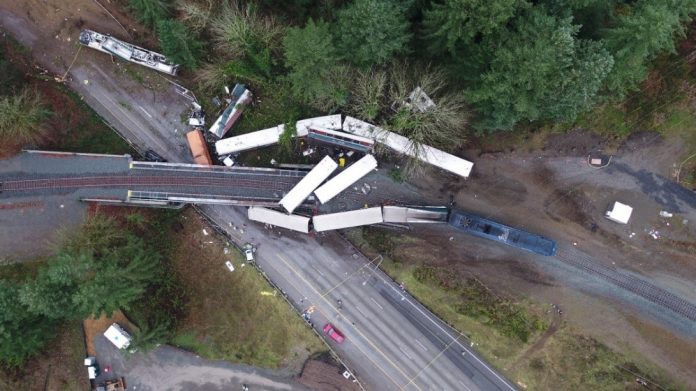America’s National Transportation Safety Board (NTSB) has released its initial findings into the train crash which killed three passengers.
The agency, which is responsible for investigating accidents on the nation’s public transport systems, estimates that more than $40.4 million (∼€33.5 million) worth of damage was caused when Amtrak train 501 derailed from a bridge near DuPont, Washington, on December 18.
NTSB said that the train was travelling at 78mph in a 30mph zone when it spilled onto the road below, coming into contact with 14 vehicles and injuring 70 in total.
Notably, it added that had positive train control (PTC) – an advanced train control system – been implemented, the train’s brakes would have been applied in line with the speed restrictions.
In the report, NTSB added: “In this accident, PTC would have notified the engineer of train 501 about the speed reduction for the curve; if the engineer did not take appropriate action to control the train’s speed, PTC would have applied the train brakes to maintain compliance with the speed restriction and to stop the train.”
NTSB said that a 30mph speed sign was posted two miles before the curve where the incident happened. In addition, there was another 30mph speed sign at the beginning of the curve.
As of publication, NTSB has not yet been able to interview either operating crew member of the lead locomotive – a 55 year-old engineer and a 48-year-old conductor – due to the injuries they sustained in the accident.
However, NTSB was able to download video from recorders from the train. It said that, from reviewing video of the accident sequence, the crew was not observed to be using any personal electronic devices.
Around six seconds prior to the derailment, NTSB said that the engineer made a comment regarding “an over speed condition.”
It added that the engineer’s actions were consistent with the application of the locomotive’s brakes just before the recording ended. It did not appear the engineer placed the brake handle in emergency braking mode.
The recording ended as the locomotive was tilting and the crew was bracing for impact.
NTSB has said that for most of its 50 year history, it has called for some form of PTC to be implemented, “to save lives.”
PTC is an advanced system that uses global positioning systems (GPS) to automatically stop a train before certain accidents occur, such as: train-to-train collisions, derailments caused by excessive speed and unauthorised train entry into work zones. If a train does not slow for an upcoming speed restriction, PTC will alert the engineer to slow the train. If an appropriate action is not taken, PTC will apply the train brakes before it violates the speed restriction.

Public transit agency Sound Transit, which owns the tracks, reported that the PTC system on this line was not operational at the time of the accident.
Congress has mandated that, under the Rail Safety Improvement Act of 2008, all Class I railroads and those providing regularly scheduled intercity or commuter rail passenger services are required to implement PTC on certain main lines by the end of 2018.
Recently US transport secretary Elaine Chao voiced her concern at the current progress and urged railroads to “greatly accelerate their efforts” to meet the deadline.
Data submitted by railroads to the Federal Railroad Administration shows that PTC systems are in operation on 45 per cent of the required route miles of track owned by freight railroads and 24 per cent of the route miles of track owned by passenger railroads, as of December 18, 2017.
Following the derailment, a spokesperson for train operator Amtrak said: “The installation of PTC on the required routes nationwide will make our whole railroad network safer. Amtrak has been a committed PTC leader – prioritising, completing and activating installation across the parts of the network that we control even as others in the industry have opposed the PTC mandate and worked to delay it.
“It is imperative that the rail industry urgently work together to get PTC activated on the national network as soon as possible – and certainly by the December 2018 federal deadline, if not before.”
Train 501 was on its first regular passenger service trip when the incident happened.
At the time of the crash, 77 passengers, five Amtrak employees and a technician from train manufacturer Talgo, which holds the current maintenance contract, were onboard.
Train 501 consisted of a leading and trailing locomotive, a power car, 10 passenger railcars and a luggage car. Its lead locomotive, the power car, and two passenger railcars all derailed onto the highway below.
NTSB said it will release a full report in due course.
Read more: Round-up: The Rail Safety Summit 2017



